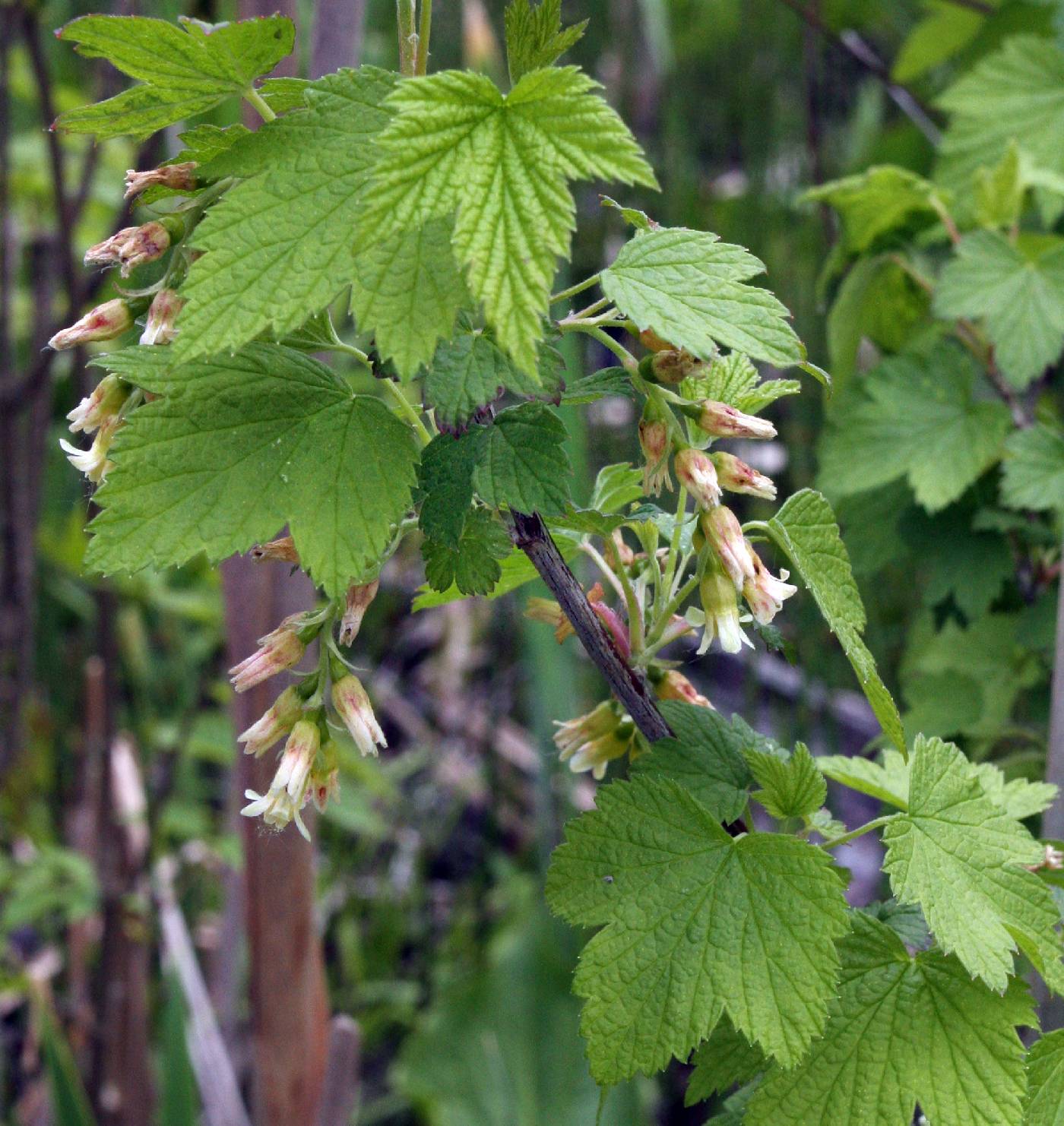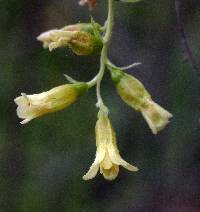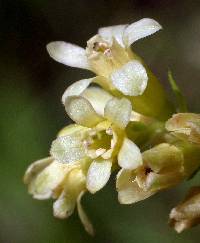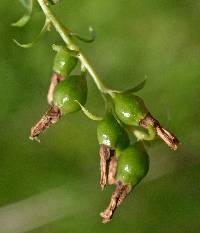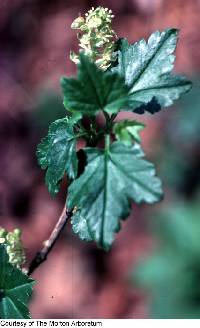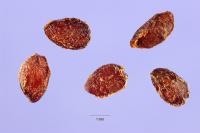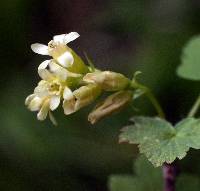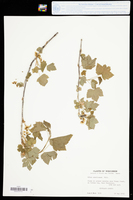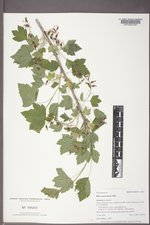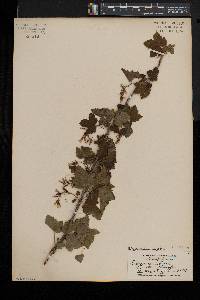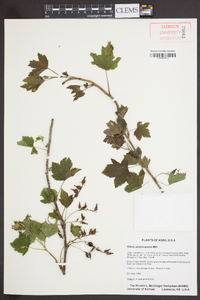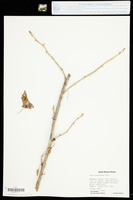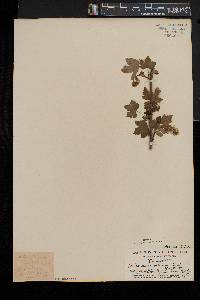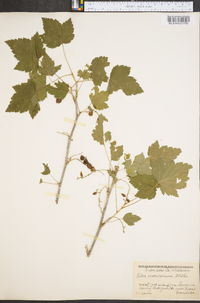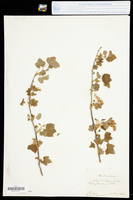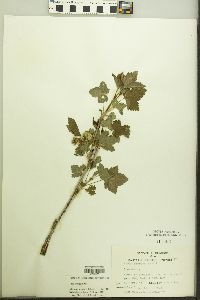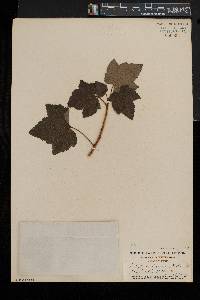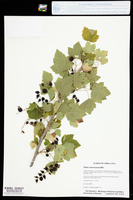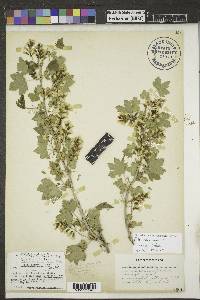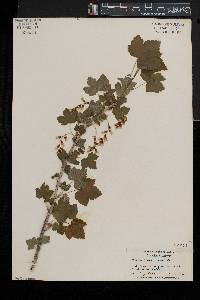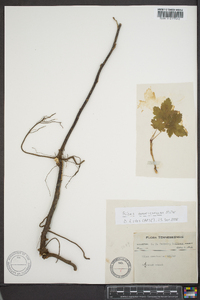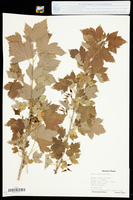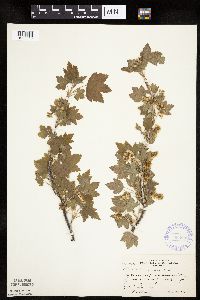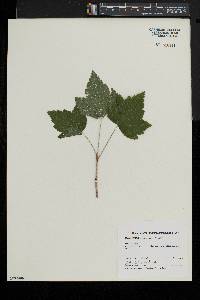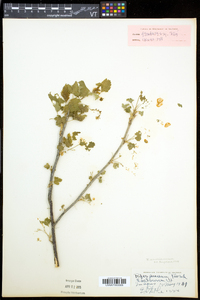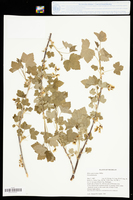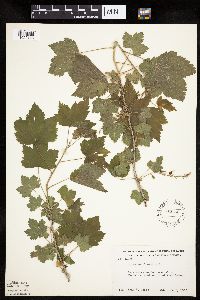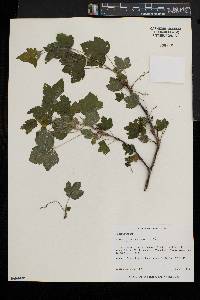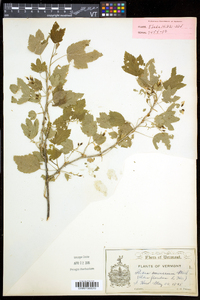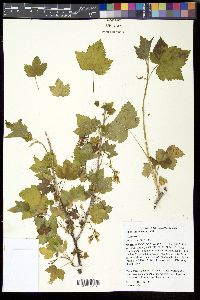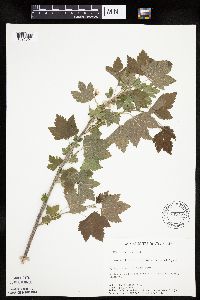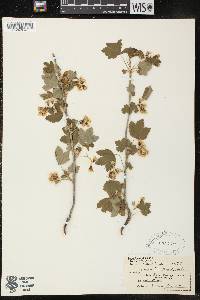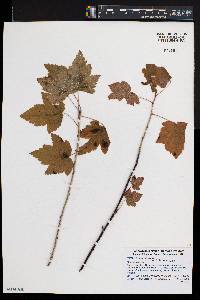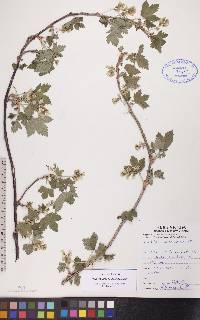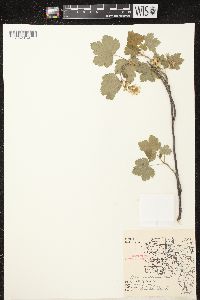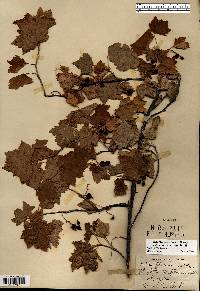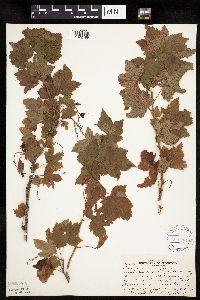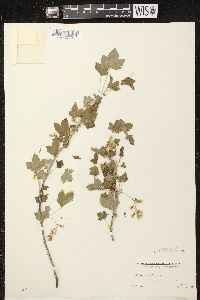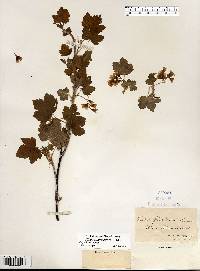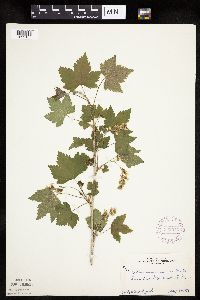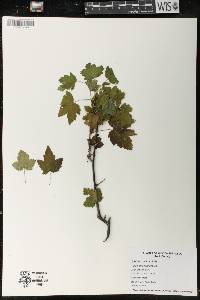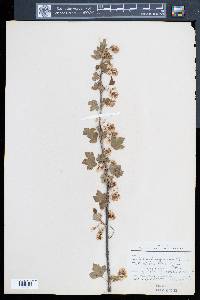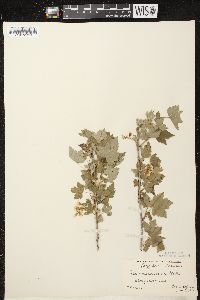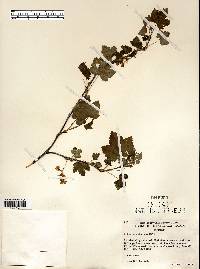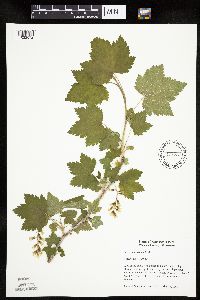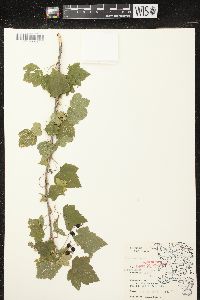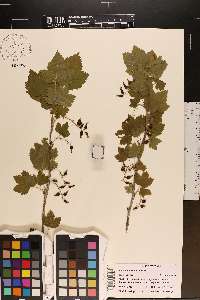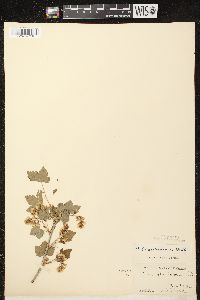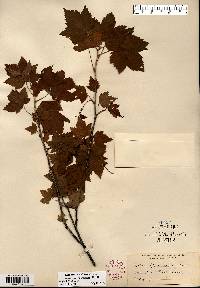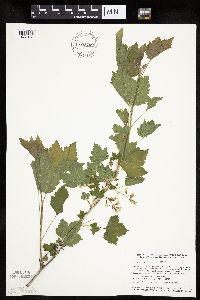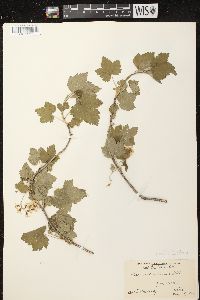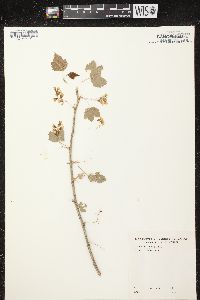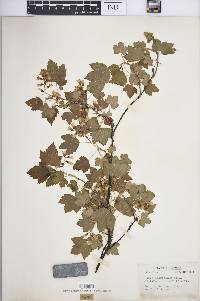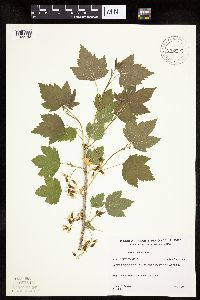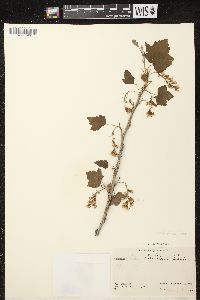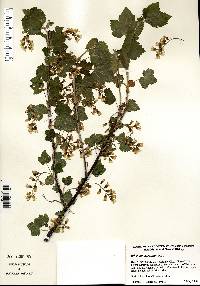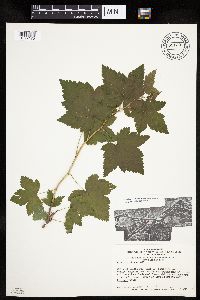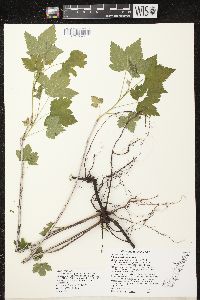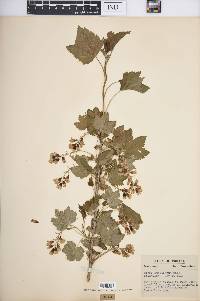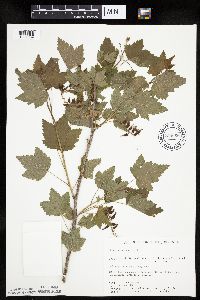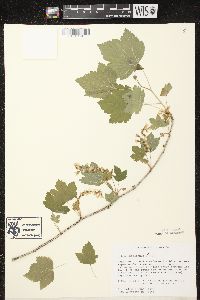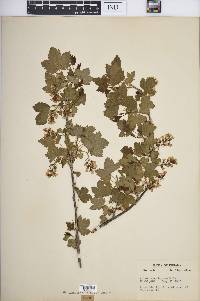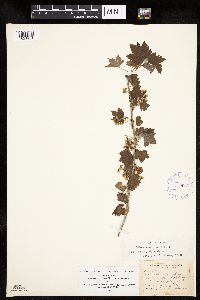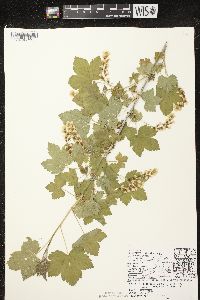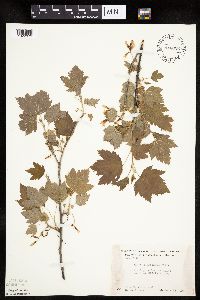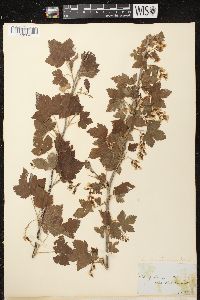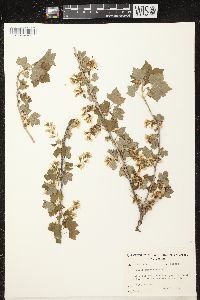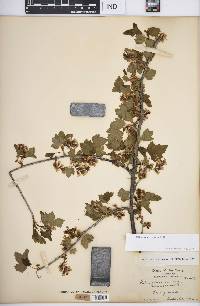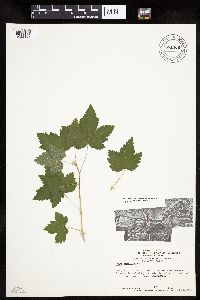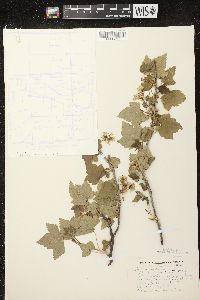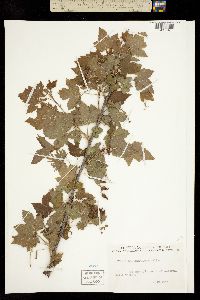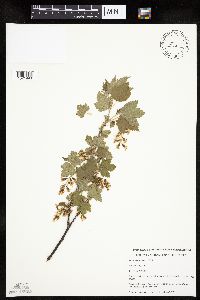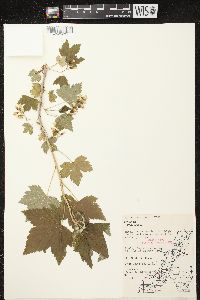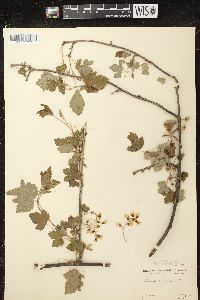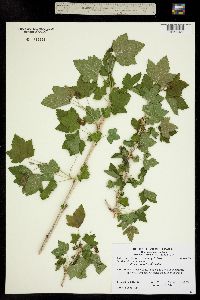
|
|
|
|
Family: Grossulariaceae
Wild Black Currant
[Ribes pensylvanicum Lam., moreRibes recurvatum Michx.] |
Plants 0.5-1.5 m. Stems erect to spreading, crisply puberulent to villous, glandular throughout with yellow, shiny, sessile, crystalline, round glands; spines at nodes absent; prickles on internodes absent. Leaves: petiole 1-7 cm, (equaling or shorter than blade), crisply puberulent to villous, with slender processes along proximal margins; blade pentangular, 3-5-lobed, cleft nearly 1/2 to midrib, (1.5-)2-7 cm, base broadly truncate to shallowly cordate, surfaces with amber, sessile glands, thickly villous at least abaxially or along abaxial veins, lobes broadly deltate, margins usually coarsely bicrenate-serrate, apex acute to bluntly acute. Inflorescences spreading to pendent, 6-15-flowered racemes, 1.5-5 cm, axis pubescent, flowers evenly spaced. Pedicels jointed, 0.1-2 mm, villous; bracts narrowly lanceolate, to 10 mm, villous to sparsely hairy. Flowers: hypanthium green, broadly tubular-campanulate, 3-4.5 mm, glabrous or sparsely villosulous; sepals not overlapping, usually reflexed, cream to greenish white, narrowly oblong-spatulate to nearly oblong, 4.5-5 mm; petals connivent, erect, whitish, oblong to oblong-obovate, not conspicuously revolute or inrolled, 2.5-3 mm; nectary disc not prominent; stamens nearly as long as petals; filaments expanded at base, 1 mm, glabrous; anthers cream, oval, 1 mm, apex with small-holed callus; ovary glabrous; styles connate nearly to stigmas, 6-8 mm, glabrous. Berries palatable when cooked, black, ovoid, 10 mm, glabrous, without resinous glands. Flowering Apr-Jun. Swamps, stream banks, wet meadows, fens, moist ravines and canyons, open woods; 50-1700 m; Alta., Man., N.B., N.S., Ont., P.E.I., Que., Sask.; Colo., Conn., Del., D.C., Ill., Ind., Iowa, Ky., Maine, Md., Mass., Mich., Minn., Mo., Mont., Nebr., N.H., N.J., N.Mex., N.Y., N.Dak., Ohio, Pa., R.I., S.Dak., Vt., Va., W.Va., Wis., Wyo.; introduced in Asia (n China). Fresh material of Ribes americanum does not have the skunklike odor of R. hudsonianum and R. nigrum. The bracts are much longer than the jointed pedicels. The leaves and bracts bear fimbriate processes on the proximal margins that may be remnants of adnate stipules.
Shrub 1 - 2 m tall Leaves: alternate, stalked, 2.5 - 6 cm long, 3 - 8 cm wide, palmately three- to five-lobed (lobes pointed), broadly egg-shaped to nearly round with a broadly flat to shallowly heart-shaped base, palmately veined, deeply to doubly saw-toothed, sparsely hairy along the veins beneath, with yellow, resinous dots. Stalk 2 - 5 cm long, sparsely yellow glandular, and hairy. Inflorescence: a small, drooping cluster (raceme) of eight to twenty or more flowers, 5 - 8 cm long, downy, subtended by elongate bracts. Bracts 6 - 10 mm long, lance-shaped to linear, and hairy. Flowers: yellowish white. Stalk 2 - 4 mm long, exceeded by the bracts. Stamens five, nearly equaling petals. Styles two, divided. Sepals: forming a five-lobed tube (calyx). Calyx yellowish white, 8 - 10 mm long, tubular bell-shaped. Lobes spreading to reflexed, 3.5 - 6 mm long, oblong to strap-shaped. Petals: five, in the throat of the calyx tube, yellowish white, 2.5 - 4.5 mm long, oblong to strap-shaped with a very blunt tip, alternate with calyx lobes. Fruit: a juicy berry, many-seeded, crowned by the shriveled calyx, black, to 1 cm wide, smooth. Stems: ascending to upright. Branchlets slender, yellow glandular, hairy, without spines. Similar species: The similar Ribes rubrum and R. triste differ by having red berries and leaves without resinous dots. Ribes nigrum is also similar but has shorter (5 - 6 mm), broadly bell-shaped, hairy calyxes. Flowering: April to early June Habitat and ecology: Common in moist woods, such as floodplains, and upland woods. Also frequent in calcareous springy places. Occurence in the Chicago region: native Etymology: Ribes comes from the Arabic name for a shrub that has acidic fruit. Americanum means "of or from the Americas." Author: The Morton Arboretum Stems erect, unarmed; lvs broadly truncate to shallowly cordate at base, 3-5-lobed, gland-dotted and sparsely villosulous beneath; racemes drooping, many fld; pedicels 0-2 mm, much exceeded by the conspicuous lanceolate bracts; hypanthium above the ovary narrowly campanulate, 3.5-4.5 mm; sep greenish-white or yellowish, oblong-ovate, 4.5-5 mm, glabrous or very sparsely villosulous; pet oblong, very blunt, 2.5-3 mm; fr black, glabrous; 2n=16. Moist woods; N.S. to Man. and Alta., s. to Del., W.Va., Ind., Io., Nebr., and Colo. Apr., May. (R. floridanum) Gleason, Henry A. & Cronquist, Arthur J. 1991. Manual of vascular plants of northeastern United States and adjacent Canada. lxxv + 910 pp. ©The New York Botanical Garden. All rights reserved. Used by permission. From Flora of Indiana (1940) by Charles C. Deam Infrequent to frequent in the lake area, becoming rare southward and probably absent from most of the unglaciated area. In the central part of the state it grows generally in wet prairie habitats and springy places and in the lake area it grows in similar habitats and in mucky places and decadent tamarack bogs. …… Indiana Coefficient of Conservatism: C = 5 Wetland Indicator Status: FACW |
|
|
|
This project was made possible in part by the Institute of Museum and Library Services [MG-70-19-0057-19].
Powered by Symbiota

